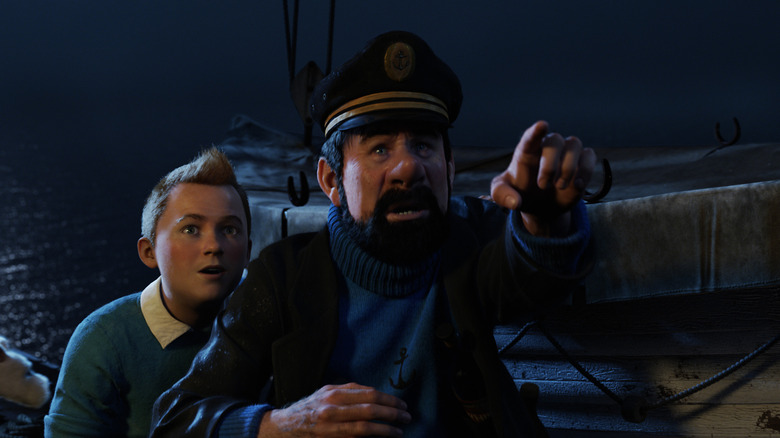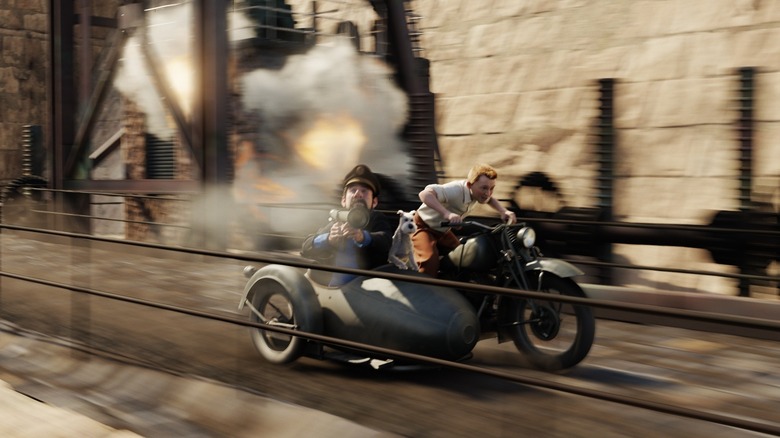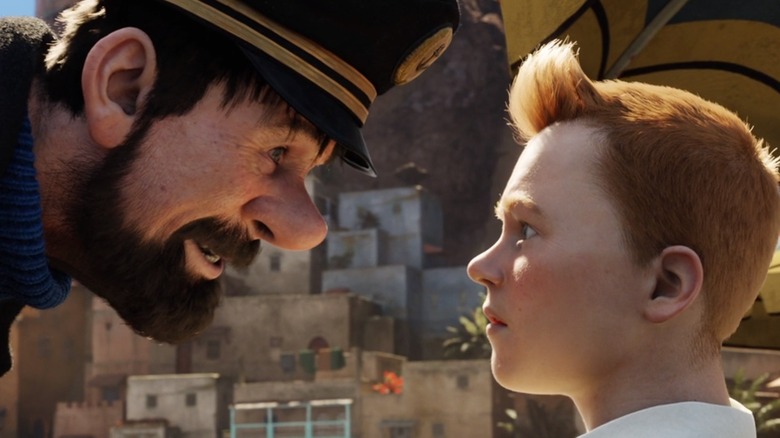That One-Shot Chase Scene In Steven Spielberg's The Adventures Of Tintin Is The Best Action Scene Ever
(Welcome to Best Action Scene Ever, a column dedicated to breaking down the best, most effective action sequences throughout the genre. In this edition, Steven Spielberg takes us to school with a one-shot masterclass in "The Adventures of Tintin")
Honestly, it's not even fair how good Steven Spielberg is at his job. You'd think that anyone would simply call it a day after breaking the mold and defining the very concept of the summer blockbuster (not even once, but twice with "Jaws" and "Jurassic Park"), pumping out family-friendly classics one after another, capturing the country's post-9/11 fears with brutal succinctness (again, with two films laying claim to that title between "Munich" and "War of the Worlds"), and taking a well-earned victory lap with the Oscar-nominated and semi-autobiographical "The Fabelmans." But noooo, the greatest filmmaker alive had to go a step further and conquer another medium altogether — motion-capture animation — and do so to incredible results.
Sure, "The Adventures of Tintin" didn't exactly light the world on fire upon release back in 2011, but time has been extraordinarily kind to this nonstop thrill ride. In fact, it serves as the ultimate example of how referring to certain movies as "roller coasters" need not even be a criticism. Starring Jamie Bell as the beloved comic book adventurer, Andy Serkis as his trusted friend Captain Haddock, and a delightful Daniel Craig as the villainous Sakharine, the performances in the film makes it abundantly clear just how much of a blast each and every main actor had along the way ... which is no small feat, considering the challenging filming conditions in which the performers acted against essentially nothing. (Check out any behind-the-scenes clip for more.)
But that only makes what Spielberg & Co. accomplished here all the more impressive. Freed from the constraints of physical, on-location shooting and limited only by the director's own imagination, the end result is a gorgeously animated movie boasting dynamic images, clever editing, and incredibly intuitive framing along the way. Yet one key sequence sums up just how smart of a decision it was to eschew live action in favor of motion-capture animation: the zany, physics-defying, and utterly brilliant "one-shot" action set piece that concludes the film's second act.
The scene
To set the scene, Spielberg's approach to the story (written by a trio of filmmakers you might have heard of: Steven Moffat, Edgar Wright, and Joe Cornish) finds young but accomplished newspaper reporter Tintin and his lovably intuitive pet dog Snowy caught up in the middle of a bitter family rivalry and a quest for sunken treasure. With the vengeance-driven Sakharine hellbent on retrieving the clues to the lost prize and the drunken Haddock desperate for a sense of redemption as the last of his family line, Tintin actually takes a backseat and becomes more of an interested observer to the grand ancestral struggle playing out in front of him. But that's not to say that he doesn't drive the action, however — far from it.
Tintin's purchase of an immaculately-crafted model of a famous sunken ship, the "Unicorn," soon attracts attention from all sorts of unsavory characters who are after the item for reasons unknown. Upon rebuffing Sakharine's slimy attempts to take it off his hands and add it to the identical model already in his possession, he resorts to thievery and soon abduction in order to coax the intrepid reporter into revealing the secret clue hidden within. Taken prisoner on a cargo ship headed to Morocco, Tintin recruits the services of the displaced Captain Haddock and escapes to foil the next stage of Sakharine's plan: a daring theft of a third model ship in broad daylight, displayed outside the mansion of a Moroccan Sheikh.
With the help of a glass-shattering operatic singer and his trusty falcon, Sakharine absconds with the third clue and seems well on his way to recovering the treasure for himself ... until Tintin springs into action and kicks off one of the most overwhelming, adrenaline-pumping, and downright audacious examples of controlled chaos in any modern blockbuster.
Why it works
Why do puppies spark joy? What makes ice cream on a blistering summer day so good? Sometimes, good things require no further explanation beyond what's already apparent ... but I have to reward your trust in me for reading this far, I suppose, so let's break this scene down anyway.
What follows is a largely computer-generated "oner" with no visible cuts as Tintin, Haddock, and Snowy on motorcycle pursue Sakharine's jeep from the manse hilltop down through the streets of the fictional Moroccan port of Bagghar. Spielberg has always paid acute attention to clear and coherent geography as a crucial aspect of action, but here he plays fast and loose with filmmaking "rules" in this exotic locale in order to bend the sequence to his will. Haddock hilariously (mis)fires a rocket that unleashes a raging river in the middle of a desert town, hopelessly complicating their chase and turning an otherwise simple sequence into a Rube Goldberg machine of moving parts. Crucially, every bit of mayhem that follows stems directly from the actions of our characters.
The director then stacks a number of spinning plates one on top of the other and brazenly hinges the entire sequence on not one, not two, but three central MacGuffins. Tintin quickly retrieves the trio of scrolls from Sakharine's grasp, but then has to contend with the unpredictable geography of the ever-shifting environment, Haddock's bumbling incompetence, and one incredibly stubborn falcon dead-set on recapturing those pesky flying papers for the bad guys. With so many distractions fighting for our attention, observant viewers are rewarded for keeping a close eye on the scrolls as they keep changing hands (and claws!) on the careening downhill journey towards the docks.
Though immersion isn't really the name of the game here (not with such purposefully heightened animation), the expert use of one long tracking shot keeps us fully invested in the stakes should our heroes fail ... which is exactly what they do at the end of this breathless set piece.
The key moment
Do you know what the difference is between a good action scene and a bad one? When you boil it down to the fundamentals, it's actually really simple: Action ought to reveal character. What puts this particular sequence in "The Adventures of Tintin" on another level isn't necessarily what unfolds in the spectacle itself, but what comes after.
Surprisingly, the manic and seemingly undefeatable efforts of our heroes throughout the chaos leads to a stunning setback at the hands of Sakharine. Having come so close to retrieving all three scrolls but forced to choose between his prize or his captured friends, Tintin makes the selfless decision and allows the enemy to win. Following such glorious highs with their lowest of emotional lows is entirely the point here, as the deceptively sharp script uses this much-needed decompressing moment to walk both Haddock and Tintin through the concept of failure — and, more importantly, never letting it defeat you. Haddock, a lifelong cynic who drowns his self-loathing in alcohol, nevetheless aspires to the greatness of his forebear, Sir Francis Haddock. Tintin, an natural optimist buoyed by a career of successes, has never tasted defeat quite like this.
Put them together, and we get a sneaky origin story of a partnership that spans decades in the original comics and, in an ideal world, would've led to several successful sequels for this movie.
As /Film's Chris Evangelista once accurately pointed out, "The Adventures of Tintin" is basically a series of action scenes strung together by the flimsiest excuse of a plot. And, no, that's not a criticism when referring to a Steven Spielberg movie. But while any number of sequences could've easily become the focal point of this article — the car chase early on when Tintin is kidnapped by Sakharine's men or the stunningly rendered ship-to-ship battle as a semi-sober Haddock remembers his grandfather's war stories — this above all else perfectly represents the ethos of the entire story.
From the motion-capture animation to the wonderfully imaginative action choreography to the emotional beats that recontextualize everything we just saw, it's clear that the intricate one-shot deserves to be ranked among the absolute best of Spielberg's filmography ... and among the best of all-time.


